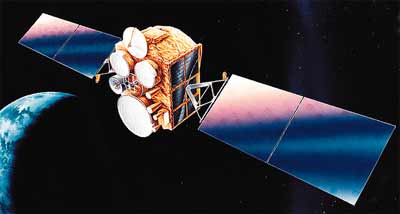Thank you very much for visiting Gunter's Space Page. I hope that this site is useful and informative for you.
If you appreciate the information provided on this site, please consider supporting my work by making a simple and secure donation via PayPal. Please help to run the website and keep everything free of charge. Thank you very much.
DSCS-3

DSCS-3 [USAF]
DSCS-3 (Defense Satellite Communications System 3) are geostationary communications satellites, which provide a robust anti-jam, nuclear hardened capability that supports Department of Defense (DoD) worldwide requirements, White House and Diplomatic communications. They are the follow-on generation of the DSCS-2 satellites.
The system is used for high priority communications such as the exchange of wartime information between defense officials and battlefield commanders. The system provides uninterrupted secure voice and high-data rate communications to globally fixed and mobile DoD users, NATO, the United Kingdom, the Diplomatic Telecommunications Service, and the White House Communications Agency.
DSCS-3 carries:
- six independent Super High Frequency (SHF) transponders and one special purpose single channel transponder operating on both SHF and Ultra High Frequency
- Three receive antennas (two Earth coverage horns, one steerable 61-beam nulling lens)
- Five transmit antennas (two Earth coverage horns, two steerable 19-beam wave guide lens, one high gain parabolic gimbaled dish)
DSCS-3 B7 also carried the CHARGECON-GEO (Charge Control at Geosynchronous Altitude, S90-3) experiment for the Space Test Program.
Two solar wings produce 1700 Watts of onboard power at the beginning of life and 1230 watts at the end of life.
DSCS-3 satellites were designed to be injected directly into GEO by the launch vehicle (Titan-34D IUS, Titan-34D Transtage or Shuttle IUS) without the need to incorporate an apogee kick engine. Switching to Atlas-2, Atlas-2A and Delta-4M launch vehicles made it necessary to include a dedicated apogee kick stage (IABS) with the satelite for injecting the DSCS-3 into GEO orbit.
Another DSCS-3 satellite was constructed under the name STARSAT to be used as a test object in the "Huron King" nuclear weapons test for the effects of system generated electromagnetic pulse (SGEMP) on a full-scale operating DSCS-3 military communications satellite. The spacecraft was contained in a large above-ground tank.
The DSCS-3 is succeeded by the WGS series of satellites.
DSCS-3 B12 was retired in 2015 and was moved into a graveyard orbit above the geostationary belt.
| Nation: | USA |
|---|---|
| Type / Application: | Communication |
| Operator: | US Air Force (USAF) |
| Contractors: | Lockheed Martin |
| Equipment: | 6 SHF transponders, 1 special purpose transponder (SHF and UHF) |
| Configuration: | DSCS-3 Bus, 3-Axis stabilization |
| Propulsion: | ? |
| Power: | 2 deployable solar arrays, batteries |
| Lifetime: | 10 years |
| Mass: | 1235 kg (2733 kg including IABS stage) |
| Orbit: | GEO |
| Satellite | COSPAR | Date | LS | Launch Vehicle | Remarks | |
|---|---|---|---|---|---|---|
| DSCS-3 A1 (#1) | 1982-106B | 30.10.1982 | CC LC-40 | Titan-34D IUS | with DSCS-2 16 | |
| DSCS-3 A2 (#4) (USA 44) | 1989-069B | 04.09.1989 | CC LC-40 | Titan-34D Transtage | with DSCS-2 15 | |
| DSCS-3 A3 (#13) (USA 167) | 2003-008A | 11.03.2003 | CC SLC-37B | Delta-4M IABS | ||
| DSCS-3 B4 (#2) (USA 11) | 1985-092B | 03.10.1985 | CCK LC-39A | Shuttle IUS | with Atlantis F-1 (STS-51-J), DSCS-3 B5 | |
| DSCS-3 B5 (#3) (USA 12) | 1985-092C | 03.10.1985 | CCK LC-39A | Shuttle IUS | with Atlantis F-1 (STS-51-J), DSCS-3 B4 | |
| DSCS-3 B6 (#14) (USA 170) | 2003-040A | 29.08.2003 | CC SLC-37B | Delta-4M IABS | ||
| DSCS-3 B7 (#9) (USA 113) | 1995-038A | 31.07.1995 | CC LC-36A | Atlas-2A IABS | ||
| DSCS-3 B8 (#11) (USA 148) | 2000-001A | 21.01.2000 | CC SLC-36A | Atlas-2A IABS | ||
| DSCS-3 B9 (#7) (USA 93) | 1993-046A | 19.07.1993 | CC LC-36A | Atlas-2 IABS | ||
| DSCS-3 B10 (#8) USA 97) | 1993-074A | 28.11.1993 | CC LC-36A | Atlas-2 IABS | ||
| DSCS-3 B11 (#12) (USA 153) | 2000-065A | 20.10.2000 | CC SLC-36A | Atlas-2A IABS | ||
| DSCS-3 B12 (#6) (USA 82) | 1992-037A | 02.07.1992 | CC LC-36A | Atlas-2 IABS | ||
| DSCS-3 B13 (#10) (USA 134) | 1997-065A | 25.10.1997 | CC LC-36A | Atlas-2A IABS | with Falcon Gold | |
| DSCS-3 B14 (#5) (USA 78) | 1992-006A | 11.02.1992 | CC LC-36A | Atlas-2 IABS | ||
| STARSAT | - | not launched |
References:
- Donald H. Martin: Communication Satellites, Aerospace Press, 1991, p 111-113
